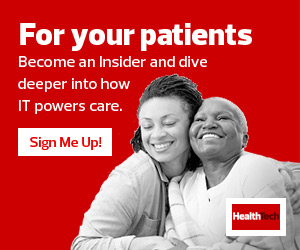Bringing the Care Continuum Home
“I think the whole concept of location-independent care is just huge,” said Tripathi, who spoke at the “Partnering Interoperability and Telehealth to Transform 21st Century Patient-Centered Care” fireside chat.
Though people often think of telehealth solely as virtual visits, Tripathi noted the vast care options available, from streaming technologies that offer real-time monitoring to smartphone apps.
He stressed the importance of nationwide interoperability and asked anyone interested in sharing their goals on the matter to submit them to the Office of the National Coordinator for Health Information Technology’s online crowdsourcing form at Health Interoperability Outcomes 2030. The deadline for submissions is July 30.
MORE FROM ATA2021: Dr. Joseph Kvedar explains what’s next for telehealth.
The ability to exchange and make sense of healthcare data is crucial as the industry shifts from a fee-for-service model to value-based care. In a session called “MeCare: The Engaged Consumer Changing the Journey of Health and Care,” panelists discussed how the home becoming the “epicenter of life operations” during the pandemic has made a profound impact on consumers.
Health economist and advisor Jane Sarasohn-Kahn, who founded the blog Health Populi, explained how the personalized care delivery of “MeCare” offers an omnichannel perspective. Heart health is especially amenable to this model, as it involves a holistic continuum of care, including diet and exercise, mental health and chronic disease management.
Dr. Manish Wadhwa, chief medical officer of the remote cardiac monitoring diagnostic services company BioTelemetry, said cardiology faces a lot of challenges. Although there are many patients because of the prevalence of heart disease in the U.S., the number of specialists could decrease as cardiologists get older and retire. The data entry burden of electronic medical records can also eat away at the time physicians can spend with patients.
But a “MeCare” approach to the cardiac care continuum can shift care from the doctor’s office to a patient’s home, with remote monitoring opportunities.
People want more care at home, Sarasohn-Kahn said, and the pandemic has primed consumers, via Zoom and other virtual encounters, to take on personalized, digital health. People are already embracing the idea of the home as a health hub, she said.
Multidisciplinary Care for Aging Patients
Making care available to patients regardless of location can also help profoundly evolve healthcare for older adults. Zahra Shariff, senior medical director of post-acute virtual care network Third Eye Health, stressed how important it is to move “the expertise to the patient versus having the patient go to the hospital, to the clinic.”
Jarrett Bauer, CEO and co-founder of virtual care provider Health Recovery Solutions, said he entered the aging space when his grandmother was readmitted to the hospital with heart failure, and he thought there was an opportunity for change when he looked into the reasons for readmission.
Virtual care solutions don’t need to be thought of as discrete, disconnected modes of care. Remote patient monitoring and video visits can absolutely work together, Bauer said.
MORE FROM ATA2021: Why telehealth is key to access for every patient population.
“I think things are blending. And I think the big thing to have in the back of your mind is not to categorize things as much as ‘which category is this?’ but ‘what is best for the patient, and what is best for the nurse?’ And I think the reality is we need a whole bunch of tools to really help nurses and physicians to be operating at the top of their licenses,” Bauer said.
Getting older adults and people with serious comorbidities the care they need has always been a challenge, and the pandemic only highlighted how unnecessary it is to expose people to risk by filling up an emergency room or a clinic.
Instead, the multidisciplinary care that happens within hospitals can and should happen within people’s homes or long-term care facilities.
“We can be there with them in their own space, and that’s what we have to work toward,” Shariff said. “Wherever it is, we need to be able to go to them.”
Building Specialty Care from the Ground Up
Breaking through those walls are virtual-first health companies that shared their experiences during a panel discussion called “On the Road to Hybrid: Opportunities and Challenges for Virtual First Organizations.” More resources on such strategies can be found at impact.dimesociety.org.
Virtual mental health platform Ginger and gastrointestinal specialty care provider Oshi Health discussed how they made the move from data analytics to providing care.
“We knew that coupling data with high-quality care, hiring the best providers — we are live in all states, we are able to provide international services as well. That was really going to be the most effective way to really change the system,” said Ginger’s chief clinical officer, Dana Udall.












